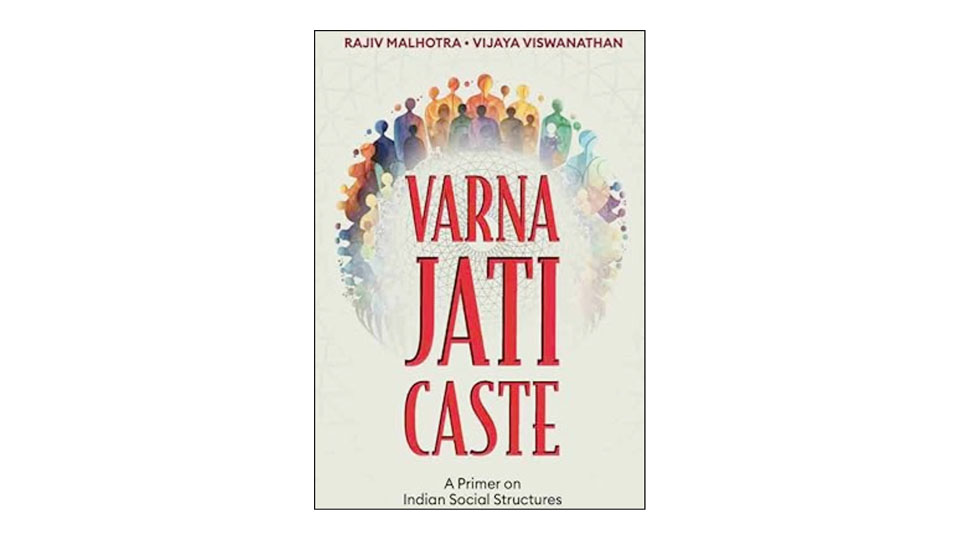By R. Chandra Prakash
Title: VARNA, JATI, CASTE – A Primer on Indian Social Structures
Authors: Rajiv Malhotra & Vijaya Viswanathan
Year: 2023
Pages: 160
Price: Rs. 250
Publisher: OCCAM, BluOne Ink LLP, India
Caste system has been arraigned for creating extreme discrimination in the Hindu society. It has also been a political tool to condemn Sanatana Dharma. Even during independence struggle caste-factor had been under the focus of political class. Dr. B.R. Ambedkar’s demand for separate electorate for ‘The Depressed Classes’ in the Provincial Assemblies, which led to the signing of the Poona Pact of 1932 between him and Mahatma Gandhi stand testimony to that. After the Mandal Commission Report of 1991, caste started to systematically make its headway in the political sphere.
The ‘intellectuals’ of Indian origin in Ivy league institutions of the United States have started campaigns alleging caste based discrimination in jobs there. Some US States have even passed laws to prevent such ‘caste based discrimination.’
With BJP coming to power at the Centre since 2014 and the emergence of Hindu political consolidation has now forced the exasperated Opposition parties, mostly dynastic and regional parties, to make the caste-factor as a main plank to regain their lost importance. No surprise that recent utterances by a group of politicians from Tamil Nadu against Sanatana Dharma and similar echoing statements from other parts of the country have been making headlines in the recent days.
So much so, the Indian National Congress (INC) party, which ever since independence had very vigorously opposed any attempt to bring the caste factor into the political discourse, is now trying to come back to power at the Centre in 2024 by competing with regional Opposition parties to carry out Caste Census!
How interesting it is that despite such a diabolic historical and political role, there is no clarity about the origin or even the existence of ‘castes’ in Sanatana Dharma! The book under review, Varna, Jati, Caste – A Primer on Indian Social Structures by Rajiv Malhotra and Vijaya Viswanathan provides much needed authentic information on this vexed subject.
Historical Contours of Castes
Authors have established with facts and figures that ‘caste’ was never a part of Hinduism. It was ‘innovated’ by the British during their Census exercises of 1830s. They state that unable to fathom the heterogeneous social classifications prevalent in the contemporary Hindu social groups, the Census Officials adopted the Portuguese term ‘caste’ as a common denominator. Thus started the ‘official’ use of caste nomenclature in the discourses of the country.
To substantiate their stand the authors provide a brief social history and explain the social fabric of Sanatana Dharma under the sub headings — 1. Early Vedic, 2. Late Vedic, 3. Dharmashastras (overlapping with 2), 4. Muslim Rule, 5. European Colonial Rule, 6. Post Independence and 7. Globalisation. They go on further to explain what our Ancient Texts state under Vedic Era, The Upanishads, The Bhagvad Gita, The Mahabharata and The Dharmashastras.
Vedic Sustainable society
The authors explain how Hinduism’s Vedic Civilisation was very scientifically evolved. They are of the opinion that “during the early Rig Veda period we come across artisans, farmers, priests and warriors. Society was basically egalitarian. We do not have evidence of a deep-seated, institutionalised and hierarchical classification of people. Even during the later Vedic and Itihasic period, the idea of varna was in its nascent form and not rigidly dependent on birth. Artisans such as metal workers, chariot-makers and carpenters were not dependent on birth… were not necessarily birth based occupational jatis.”
Megasthenes is quoted as having said that slavery was unknown in India, no Indian slave existed and all Indians were free. Greek writers refer to the Shudras as Sodrai and describe them as an important community of northwest India at the time of Macedonian king, Alexander (326 BCE). “This is contrary to the view presented by modern scholars that Shudras and Dalits have been slaves since Vedic times.”
Manusmriti
It is a fashion these days to blame Manusmriti for creating the present caste system. However, “The Manusmriti explains that jatis originated due to intermarriage between different varnas. This shows that different varnas did inter-marry. Thus, sixty-one jatis are mentioned in the Manusmriti and more than one hundred are mentioned in the Brahmavaivarta Purana… During the post Maurya period (187BCE-320CE) there were inter-marriages between different varnas and jatis were giving birth to newer jatis.”
As per available information there is common agreement that birth based varna came after the Vedic period and untouchability came after Buddhism. It can be seen that “Many rishis were born as non-Brahmins…Valmiki (author of the Ramayana) and Vyasa (author of Mahabharata, and editor/compiler of Vedas) and even the great sage, Vashista. They were all born in the lowest strata. Kalidasa, respected as the greatest Sanskrit poet, came from a humble and obscure origin.”
Dharmashastras and Manusmriti are accused of inculcating the practice of untouchability. On the contrary, as per these texts persons following disapproved vocations (hunting, butchery etc.) became untouchables.
The authors try to analyse the core Hindu texts to prove that the modern scholarship has been unreliable and reductionist, and deserves to be contested.
[To be continued]








Recent Comments